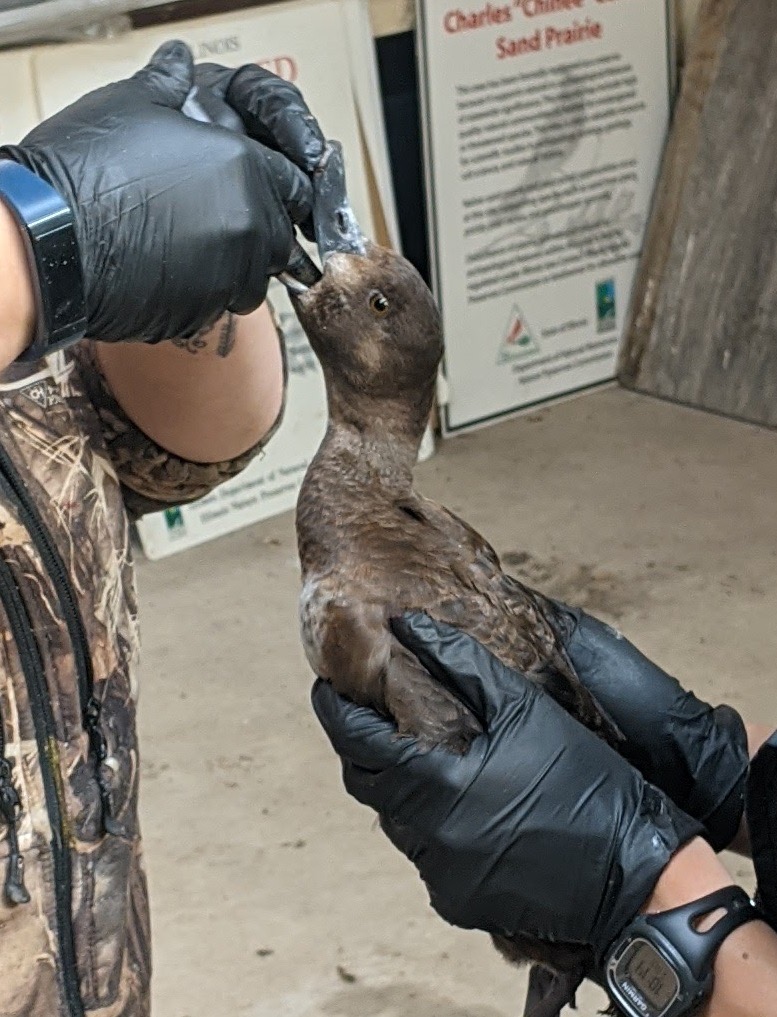
Photo by Gary Kramer, USFWS.



Photo by Gary Kramer, USFWS.

Lesser scaup (Aythya affinis) are the most abundant diving duck in North America, but their population numbers have been in decline for almost 50 years without a clear explanation despite rigorous research efforts. This has led researchers to explore the role that epizootic diseases play in scaup population dynamics. Since the early 2000s, thousands of scaup have died annually on the Upper Mississippi River near La Crosse, WI during migration from intestinal trematode infections. Waterfowl and waterbirds become infected with these exotic trematodes (Cyathocotyle bushiensis and Sphaeridiotrema spp.) after consuming invasive faucets snails (Bithynia tentaculata).
Faucet snails, and the trematodes, were unintentionally introduced to North America in the late 1800s from shipping material and ballast water of European trade ships. Though most trematode infections do not result in death, it is unclear why scaup in the Mississippi River are disproportionately affected by the trematode infections. As the faucet snail continues to expand its range and threaten major scaup migration stopover areas of the Mississippi River, waterfowl managers are becoming increasingly concerned for scaup populations.

To help inform scaup management decisions, we conducted trematode infection experiments with captive scaup at Western Illinois University and Forbes Biological Station in Havana. Generally, we found that birds that had greater trematode infections had more intense physiological responses and used more of their bodily resources, such as fat and trace nutrient reserves. Female scaup were more susceptible to trematode infections compared to male scaup and they had less fat reserves overall compared to male scaup.
Scaup encounter these trematodes more often during spring migration, as opposed to fall migration, as they are nearing their breeding range. They stop in areas of the Mississippi River, where faucet snails and trematodes are present, to refuel during migration. In their efforts to replenish bodily reserves, they acquire trematode infections and are forced to utilize their reserves to fight the infections. If the infections are too severe and the birds’ reserves are depleted, they will succumb to mortality, but more likely, the infection will not be severe and they will survive, though with depleted reserves and in a compromised state. When considering the impacts these trematode infections may have on scaup breeding and reproductive potential, the condition that female scaup are in after trematode infections is important. Because female scaup are more susceptible to infections and depleting their bodily reserves there is a possibility that their breeding and reproductive potential is compromised after trematode infections.

It would be nearly impossible to control faucet snail populations but managing the interactions between scaup and faucet snails could help mitigate the effects of trematode infections. Increasing the quantity and quality of migratory stopover locations in areas where faucet snails do not occur is a key component of managing scaup and faucet snail interactions. Further research into the impacts trematode infections have on scaup population dynamics could provide better insight into the management of scaup in North America.
Cheyenne Beach is a PhD student at Northern Illinois University studying the impacts epizootic diseases have on lesser scaup breeding and reproductive efforts. In 2021, she graduated from Western Illinois University with a MSc in Biology where she researched lesser scaup physiological responses to epizootic diseases. She grew up on a hobby farm in Waterville, NY, a small town in upstate New York, and has always been interested in working in the outdoors. Beach thoroughly enjoys researching the ecology and management of waterfowl, waterbirds, and the habitats they require throughout their lives.
Submit a question for the author